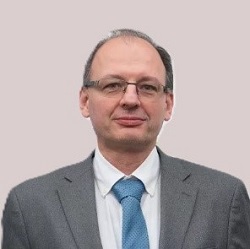- Speaker
- Prof. Ádám Gali
- HUN-REN Wigner Research Centre for Physics & Budapest University of Technology and Economics
- Abstract
To implement quantum algorithms and applications, we must first realize quantum bits. Based on their roles in quantum information processing, we distinguish two types of physical qubits: local qubits, which enable quantum computation or measurement within a quantum device, and flying qubits, which are responsible for transmitting quantum information between different quantum devices. Photons are the natural realization of flying qubits, as they can connect spatially separated quantum systems. However, photons are not suitable for local storage of quantum information, so local qubits are typically material-based and manipulated in place. A quantum interface that connects local and flying qubits is essential for establishing communication between quantum devices. This concept underlies so-called entanglement-based quantum links, which enable, for example, distributed quantum computation.
To address the above challenges, one of the most promising local qubit types is the color center embedded in solids. These are typically created by point defects. A key representative of this qubit class is the nitrogen-vacancy (NV) center in diamond. The negatively charged NV center has a paramagnetic triplet electronic ground state, making it both magnetically active and optically addressable. Its fluorescence intensity depends on the spin state in the ground state (enabling qubit readout), and under continuous optical excitation, the spin can be polarized into a specific state with nearly 100% probability (qubit initialization). Coherent coupling between photon emission and electron spin enables the implementation of a spin-photon interface, recently used to demonstrate a small-scale quantum network. This gives NV centers a major advantage over, for instance, superconducting qubits, which emit photons in the THz range that are very difficult to coherently link to optical photons.
As this brief introduction shows, the physics of color center qubits—i.e., the science of coherently manipulating spins in solids—lies at the intersection of quantum optics and solid-state physics and can be regarded as a specialized branch of the latter.
In this talk, I provide an overview of the theory of solid-state defect qubits [1,2], beginning with the nitrogen-vacancy (NV) center in diamond to highlight the key magneto-optical parameters that underpin qubit operation. I then demonstrate how these principles can be extended to other defects in a variety of host materials, including wide-bandgap semiconductors such as silicon carbide and, notably, silicon—a cornerstone of the electronics industry [3].
[1] A. Gali, Nanophotonics 8, 1907 (2019).
[2] A. Gali, Nanophotonics 12, 359 (2023).
[3] G. Zhang, Y. Cheng, J-P. Chou, and A. Gali, Applied Physics Reviews 7, 031308 (2020).
- About the Speaker
Dr. Ádám Gali is a professor at the Hungarian Research Network - Wigner Research Centre for Physics and a professor at the Budapest University of Technology and Economics (BME). He coordinates the Quantum Information National Laboratory of Hungary and is a Director of Research at the Institute of Solid State Physics and Optics at Wigner Research Centre for Physics. He is an associate member of CSRC since 2025. He is best known for his great contribution in the theory of color centers. He has developed advanced density functional theory methods to explore optical and magnetic properties of diamond and SiC defects. His predictions on defect qubits have been experimentally confirmed, leading to landmark publications, and he now leads experiments on quantum technology.
- Date&Time
- 2025-09-08 2:00 PM
- Location
- Room: Conference Room I




